Small Ruminants Grazing as a Rehabilitative Land Management Tool in the Negev Highland; Soil, Geomorphological and Topographical Perspectives
Abstract
Highlights
- The liquid excretion of SR enriches the wadis’ slopes with Nitrogen and Phosphorus;
- The digested droppings of the SR enriches the slopes with organic matter;
- The organic matter from the SR excretion forms a colluvial layer on wadi channel banks;
- Planned and managed SR grazing may be used as a land management tool for wadis’ area.
1. Introduction
2. Material and Methods
2.1. Site of Study
2.2. Determining the Grazing Patterns of the Area
2.3. Determining the Evolution of Geographical and Geomorphological Outlines
2.4. Locating the Sampling Plots over the Transect
2.5. Soil Properties Measurements
3. Results
3.1. Grazing Patterns
3.2. The Evolution of Geography, and Geomorphology of the Area
3.3. Influence of the Geographic Outlines of Wadi on Its Herbaceous Coverage
3.4. Influence of Grazing on Wadi Slopes on Soil Properties
4. Discussion
4.1. The Interrelation between Grazing and Wadi’s Fertility
4.2. Suggestions for In-Field Implementation
5. Conclusions
Supplementary Materials
Author Contributions
Funding
Institutional Review Board Statement
Informed Consent Statement
Data Availability Statement
Acknowledgments
Conflicts of Interest
Abbreviations
| HBW | Herbaceous biomass weight |
| SMC | Soil moisture content |
| SOM | Soil organic matter |
| SR | Small ruminants (goat and sheep) |
| WOS | Wadi or Wadis (dry channel in arid regions) |
References
- Alexandrov, Y.; Laronne, J.B.; Reid, I. Intra-event and inter-seasonal behaviour of suspended sediment in flash floods of the semi-arid northern Negev, Israel. Geomorphology 2007, 85, 85–97. [Google Scholar] [CrossRef]
- Gong, J.G.; Jia, Y.W.; Zhou, Z.H.; Wang, Y.; Wang, W.L.; Peng, H. An experimental study on dynamic processes of ephemeral gully erosion in loess landscapes. Geomorphology 2011, 125, 203–213. [Google Scholar] [CrossRef]
- Abdel-Fattah, M.; Saber, M.; Kantoush, S.A.; Khalil, M.F.; Sumi, T.; Sefelnasr, A.M. A hydrological and geomorphometric approach to understanding the generation of wadi flash floods. Water 2017, 9, 553. [Google Scholar] [CrossRef]
- Mor-Mussery, A.; Laronne, B.J. The effects of gully’ erosion on the ecology of arid loess agro-ecosystems. Wadi Atir area, the northern Negev a case study. Catena 2020, 104712. [Google Scholar] [CrossRef]
- Al-Rowaily, S.L.; El-Bana, M.I.; Al-Dujain, F.A. Changes in vegetation composition and diversity in relation to morphometry, soil and grazing on a hyper-arid watershed in the central Saudi Arabia. Catena 2012, 97, 41–49. [Google Scholar] [CrossRef]
- Al-Rowaily, S.L.; El-Bana, M.I.; Al-Bakre, D.A.; Assaeed, A.M.; Hegazy, A.K.; Basharat, A.l.M. Effects of open grazing and livestock exclusion on floristic composition and diversity in natural ecosystem of Western Saudi Arabia. Saudi J. Biol. Sci. 2015, 22, 430–434. [Google Scholar] [CrossRef]
- Moosavi, S.; Grose, M.J.; Lake, P.S. Wadis as dryland river parks: Challenges and opportunities in designing with hydro-ecological dynamics. Landsc. Res. 2019, 45. [Google Scholar] [CrossRef]
- Mor-Mussery, A.; Helman, D.; Agmon, Y.; Ben Shabat, I.; El-Frejat, S.; Goldman-Golan, D. The indigenous Bedouin farmers as land rehabilitators—Setup of an action research programme in the Negev. Land Degrad. Dev. 2020, 31, 2533–2539. [Google Scholar] [CrossRef]
- Avni, Y. Gully incision as a key factor in desertification in an arid environment, the Negev highlands, Israel. Catena 2005, 63, 185–220. [Google Scholar] [CrossRef]
- Beckers, B.; Berking, J.; Schütt, B. Ancient water harvesting methods in the drylands of the Mediterranean and Western Asia. eTopoi. J. Anc. Stud. 2013, 2, 145–164. Available online: http://www.topoi.org/wp-content/uploads/2013/06/174-693-1-SM.pdf (accessed on 26 August 2021).
- Crouvi, O.; Amit, R.; Porat, N.; Gillespie, A.R.; McDonald, E.V.; Enzel, Y. Significance of primary hilltop loess in reconstructing dust chronology, accretion rates, and sources: An example from the Negev Desert, Israel. J. Geophys. Res. Space Phys. 2009, 114. [Google Scholar] [CrossRef]
- Hillel, D.; Tadmor, N. Water regime and vegetation in the central Negev highlands of Israel. Ecology 1962, 43, 33–41. [Google Scholar] [CrossRef]
- Abdel-Khalik, K.; Al-Gohary, I.; Al-Sodany, Y. Floristic composition and vegetation: Environmental relationships of wadi fatimah, mecca, Saudi Arabia. Arid. Land Res. Manag. 2017, 31, 316–334. [Google Scholar] [CrossRef]
- Donsky, N. Memorandum for Construction of New Bedouin Village, Rahma; Code No. 804-11-1; The Authority for Regularization of the Bedouin Settlement in the Negev: Negev, Israel; T.I.K Projects®, Bee’r Sheva: Be’er Sheva, Israel, 2014. (In Hebrew) [Google Scholar]
- Dorji, T.; Totland, Ø.; Moe, S.R. Are droppings, distance from pastoralist camps, and pika burrows good proxies for local grazing pressure? Rangelands Ecol. Manag. 2013, 66, 26–33. [Google Scholar] [CrossRef]
- Sparks, D.L.; Page, A.L.; Helmke, P.A.; Loeppert, R.H. (Eds.) Methods of Soil Analysis, Part 3: Chemical Methods; John Wiley & Sons: Hoboken, NJ, USA, 2020; Volume 14. [Google Scholar]
- Schenk, H.J.; Jackson, R.B. Rooting depths, lateral root spreads and below-ground/above-ground allometries of plants in water-limited ecosystems. J. Ecol. 2002, 90, 480–494. [Google Scholar] [CrossRef]
- Bonham, C.D. Measurements for Terrestrial Vegetation; John Wiley & Sons: Hoboken, NJ, USA, 2013. [Google Scholar]
- Hassen, H.; Rischkowsky, B.; Termanini, A.; Jessry, G.; Haile, A.; Baum, M.; Lababidi, S. Morphological and molecular genetic diversity of Syrian indigenous goat populations. Afr. J. Biotech. 2016, 15, 745–758. [Google Scholar] [CrossRef][Green Version]
- Roba, H.G.; Oba, G. Efficacy of integrating herder knowledge and ecological methods for monitoring rangeland degradation in northern Kenya. Hum. Ecol. 2009, 37, 589–612. [Google Scholar] [CrossRef]
- Fryxell, J.M.; Wilmshurst, J.F.; Sinclair, A.R. Predictive models of movement by Serengeti grazers. Ecology 2004, 85, 2429–2435. Available online: https://www.jstor.org/stable/3450241 (accessed on 26 August 2021). [CrossRef]
- Molnár, Z.; Kelemen, A.; Kun, R.; Máté, J.; Sáfián, L.; Provenza, F.; Díaz, S.; Barani, H.; Biró, M.; Máté, A.; et al. Knowledge co-production with traditional herders on cattle grazing behaviour for better management of species-rich grasslands. J. Appl. Ecol. 2020, 57, 1677–1687. [Google Scholar] [CrossRef]
- Avornyo, F.K.; Zougmore, R.B.; Partey, S.T.; Tengan, K. Candidate fodder trees and shrubs for sustainable ruminant production in northern Ghana. Livest. Res. Rural. Dev. 2018, 30, 1–8. Available online: http://www.lrrd.org/lrrd30/9/favor30154.html (accessed on 26 August 2021).
- Cao, Z.; Zhang, K.; He, J.; Yang, Z.; Zhou, Z. Linking rocky desertification to soil erosion by investigating changes in soil magnetic susceptibility profiles on karst slopes. Geoderma 2021, 389, 114949. [Google Scholar] [CrossRef]
- Shand, C.A.; Coutts, G. The effects of sheep feces on soil solution composition. Plant Soil 2006, 285, 135–148. [Google Scholar] [CrossRef]
- Ogejo, J.A.; Wildeus, S.; Knight, P.; Wilke, R.B. Estimating goat and sheep manure production and their nutrient contribution in the Chesapeake Bay watershed. Appl. Eng. Agric. 2010, 26, 1061–1065. [Google Scholar] [CrossRef]
- Al-Sodany, Y.M.; Fadl, M.A.; Farrag, H.F.; Saif, T.Y. Effect of Dams on the vegetation of arid regions. J. Environ. Sci. Water Res. 2015, 4, 71–91. [Google Scholar]
- Missimer, T.M.; Guo, W.; Maliva, R.G.; Rosas, J.; Jadoon, K.Z. Enhancement of wadi recharge using dams coupled with aquifer storage and recovery wells. Environ. Earth Sci. 2015, 73, 7723–7731. [Google Scholar] [CrossRef]
- Mor-Mussery, A.; Shuker, S.; Zaady, E. New approach for sustainable and profitable grazing systems in arid open lands—A case study in the northern Negev. Geogr. Environ. Sustain. 2019, 12, 106–127. [Google Scholar] [CrossRef]
- Gregorini, P.; Provenza, F.D.; Villalba, J.J.; Beukes, P.C.; Forbes, M.J. Dynamics of forage ingestion, oral processing and digesta outflow from the rumen: A development in a mechanistic model of a grazing ruminant, MINDY. J. Agric. Sci. 2018, 8, 980–995. [Google Scholar] [CrossRef]
- Delve, R.J.; Cadisch, G.; Tanner, J.C.; Thorpe, W.; Thorne, P.J.; Giller, K.E. Implications of livestock feeding management on soil fertility in the smallholder farming systems of sub-Saharan Africa. Agric. Ecosyst. Environ. 2001, 84, 227–243. [Google Scholar] [CrossRef]
- Treweek, G.; Di, H.J.; Cameron, K.C.; Podolyan, A. Simulated animal trampling of a free-draining stony soil stimulated denitrifier growth and increased nitrous oxide emissions. Soil Use Manag. 2016, 32, 455–464. [Google Scholar] [CrossRef]
- Baddock, M.C.; Zobeck, T.M.; Van Pelt, R.S.; Fredrickson, E.L. Dust emissions from undisturbed and disturbed, crusted playa surfaces: Cattle trampling effects. Aeolian Res. 2011, 3, 31–41. [Google Scholar] [CrossRef]
- Owen, J.J.; Amundson, R.; Dietrich, W.E.; Nishiizumi, K.; Sutter, B.; Chong, G. The sensitivity of hillslope bedrock erosion to precipitation. Earth Surf. Proc. Landforms 2011, 36, 117–135. [Google Scholar] [CrossRef]
- Zhao, W.; Walker, S.L.; Huang, Q.; Cai, P. Adhesion of bacterial pathogens to soil colloidal particles: Influences of cell type, natural organic matter, and solution chemistry. Water Res. 2014, 53, 35–46. [Google Scholar] [CrossRef] [PubMed]
- Beyene, F. Incentives and challenges in community-based rangeland management: Evidence from eastern Ethiopia. Land Degrad. Dev. 2015, 26, 502–509. [Google Scholar] [CrossRef]
- Norris, A.B.; Smith, W.B. Farming characteristics and manure management of small ruminant and cervid livestock. Anim. Manure Prod. Charact. Environ. Concerns Manag. 2019, 67, 129–144. [Google Scholar]
- Peischel, A.; Henry, D.D. Targeted Grazing: A Natural Approach to Vegetation Management and Landscape Enhancement American Sheep Industry Association (ASI); Launchbaugh, K., Ed.; Rangeland Ecology and Management Department, University of Idaho: Moscow, ID, USA, 2006; Available online: https://studylib.net/doc/12150284/targeted-grazing--a-natural-approach-to-vegetation- management-landscape-enhancement.pdf (accessed on 26 August 2021).
- Smith, R.F.; Oultram, J.; Dobson, H. Herd monitoring to optimise fertility in the dairy cow: Making the most of herd records, metabolic profiling and ultrasonography (research into practice). Animal 2014, 8, 185–198. [Google Scholar] [CrossRef] [PubMed]
- Leu, S.; Ben-Eli, M.; Mor-Mussery, A. Effects of grazing control on ecosystem recovery, biological productivity gains, and soil carbon sequestration in long-term degraded loess farmlands in the Northern Negev, Israel. Land Degrad. Dev. 2021, 32, 2580–2594. [Google Scholar] [CrossRef]
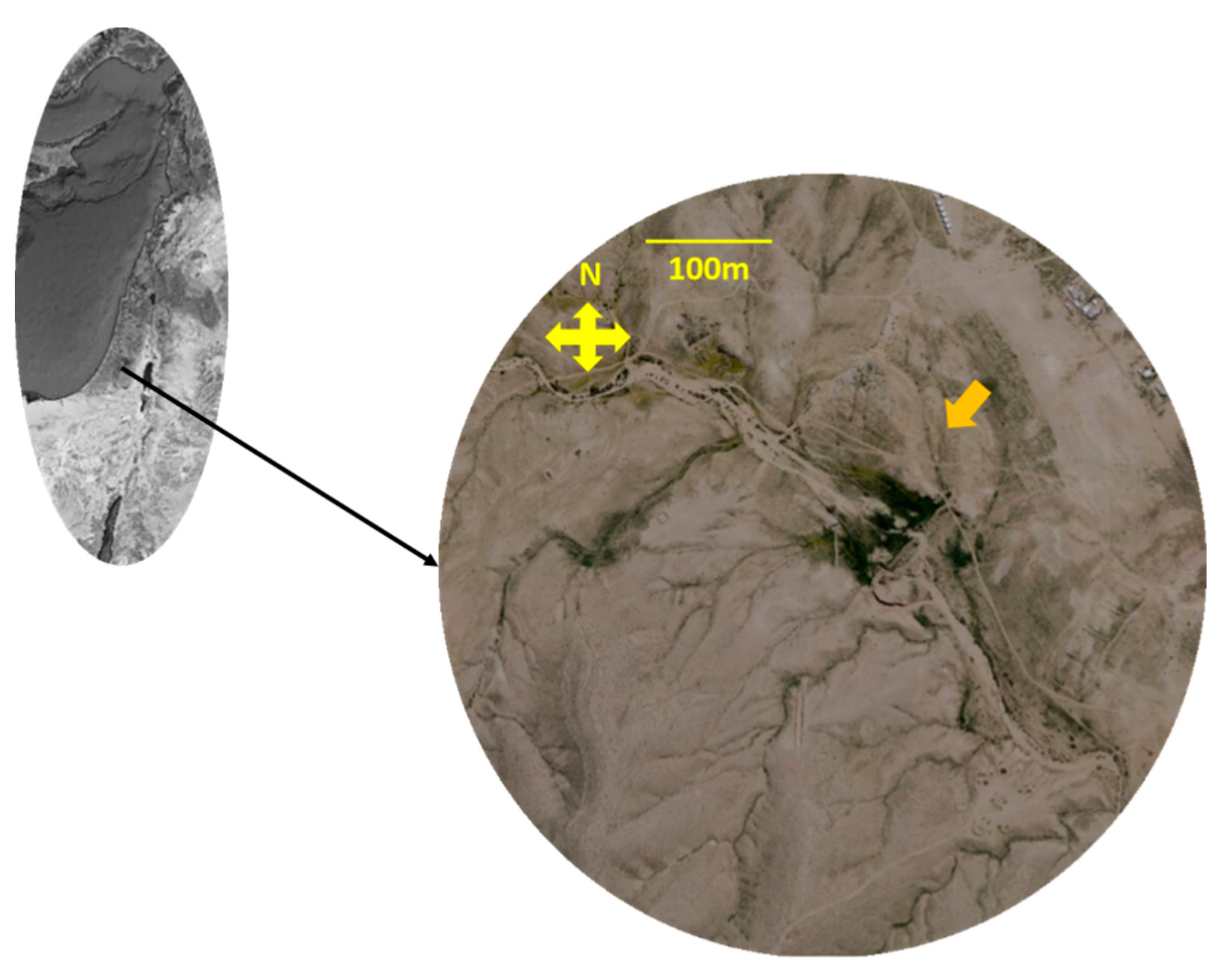
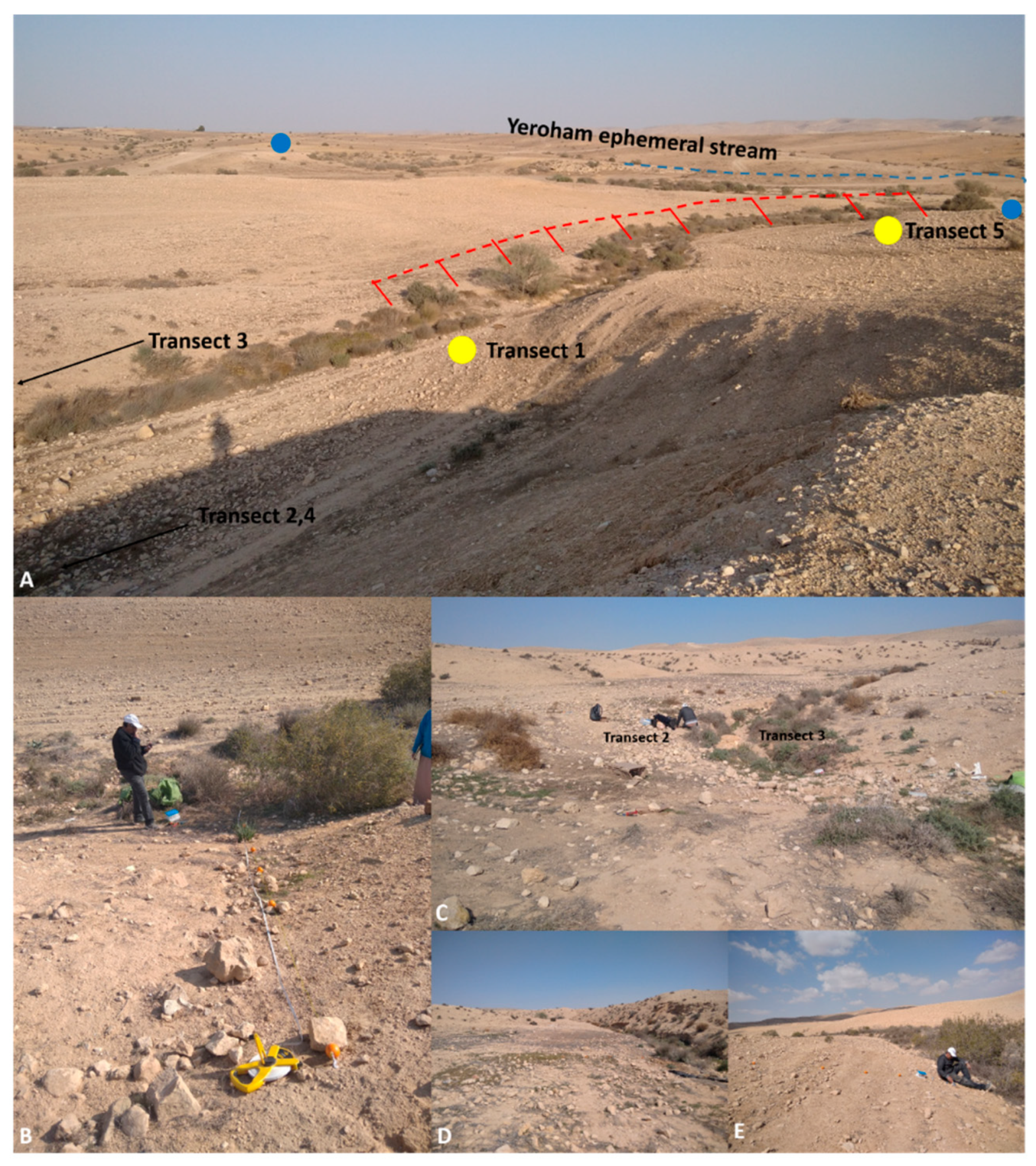
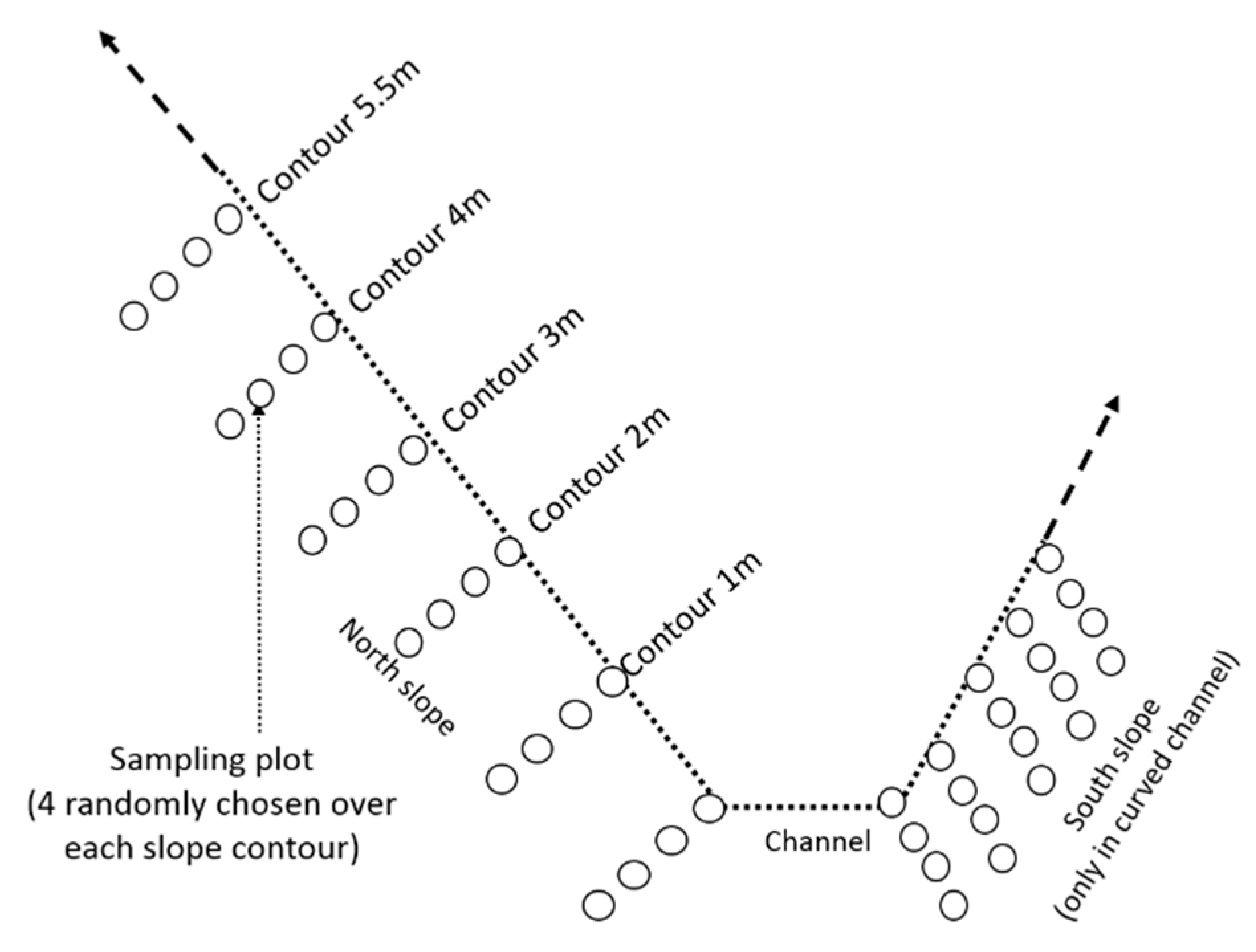
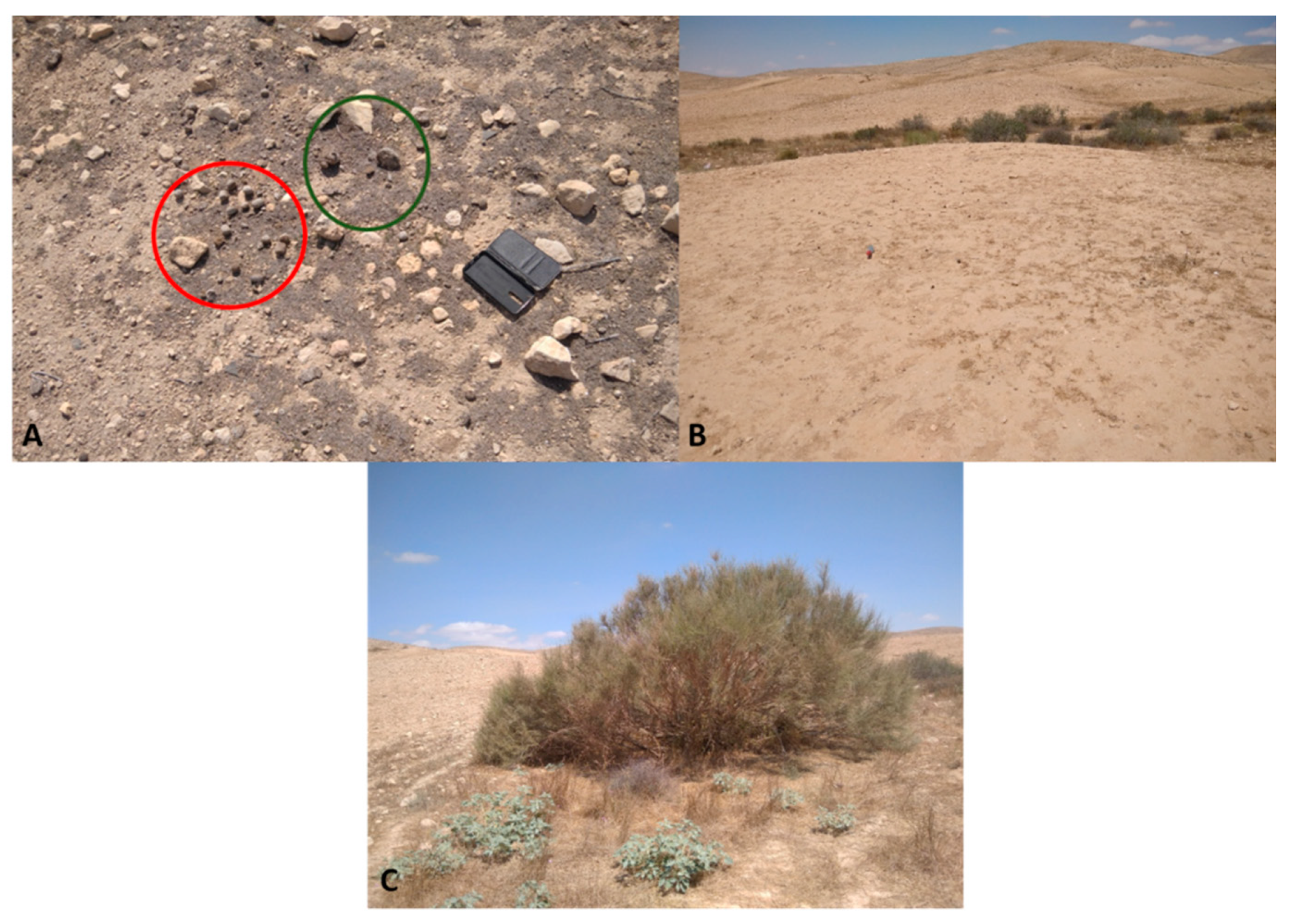



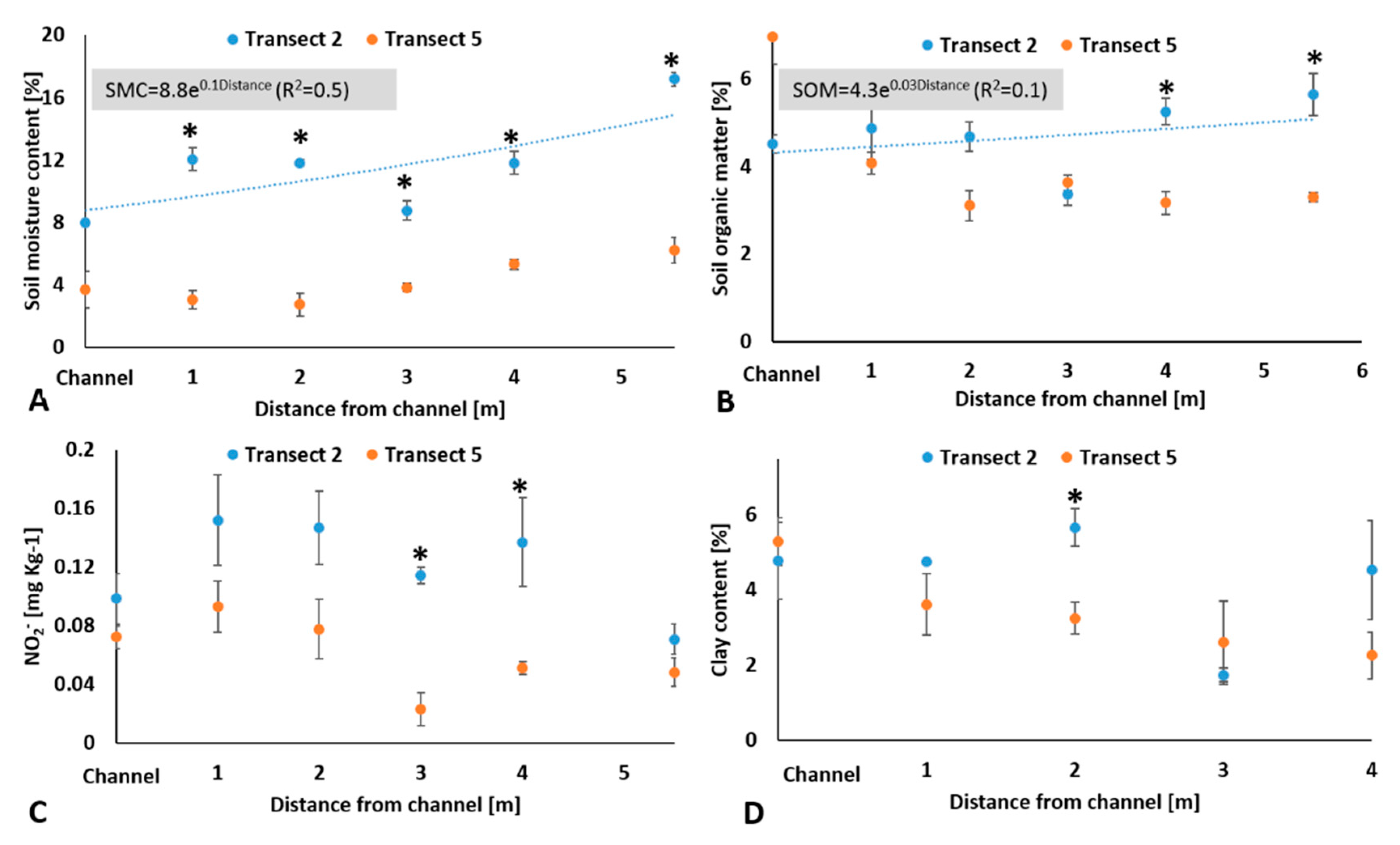
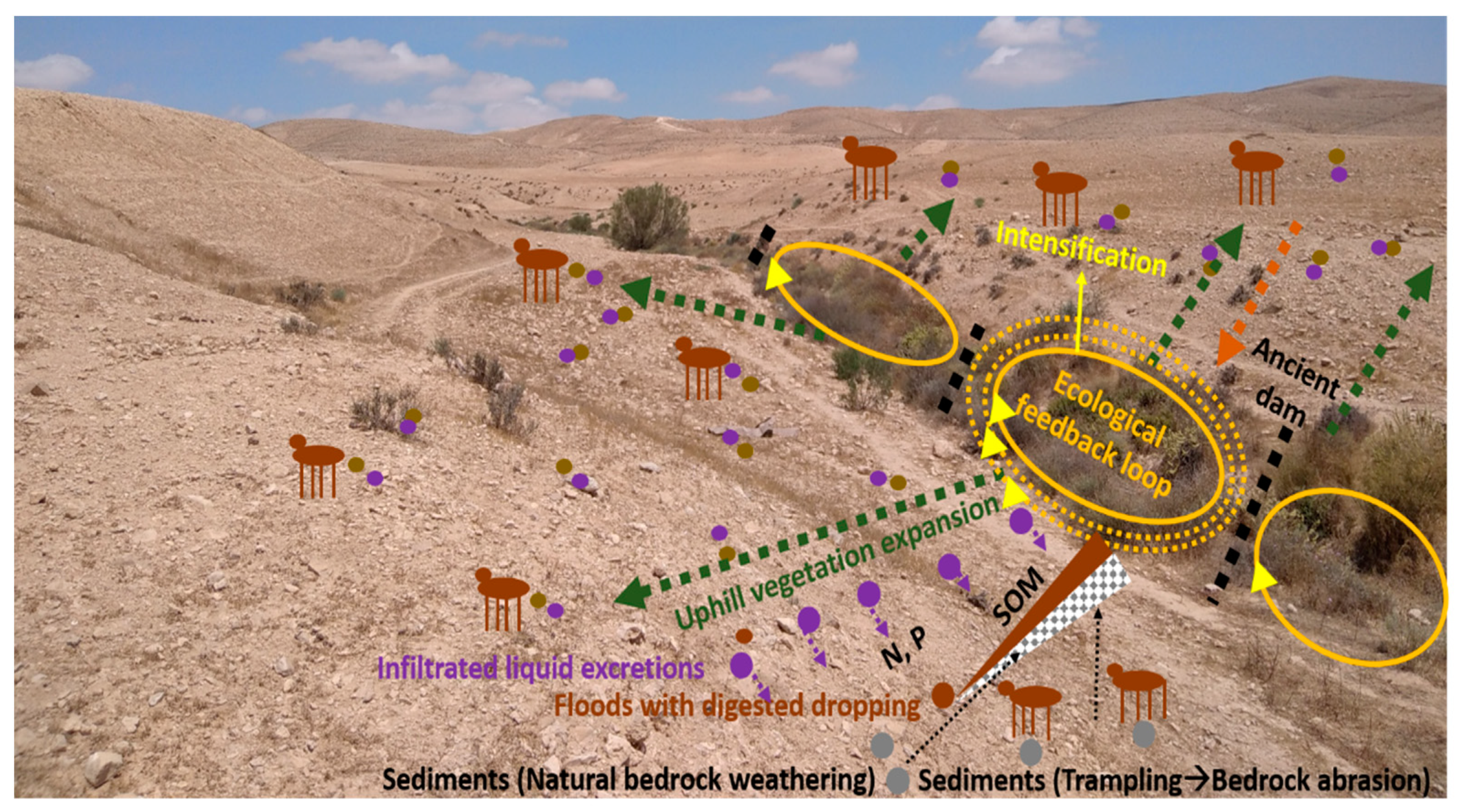
| Transect No. | Graz. | Aspect | Slope Incl. (%) | Pedo. | Shape | Channel Width * | Dam. |
|---|---|---|---|---|---|---|---|
| 1 (50 m) | + | South | 4 | Regolith | Straight | Wide | + |
| 2 (100 m) | + | South | 3 | Regolith | C.Outward | Narrow | − |
| 3 (100 m) | + | North | 3.5 | Regolith | C.Inward | Narrow | − |
| 4 (130 m) | + | South | 1 | Loess | Straight | Narrow | − |
| 5 (80 m) | - | South | 3 | Regolith | Straight | Wide | + |
| Analyzed Properties | Description |
|---|---|
| Soil | |
| Soil moisture content (SMC) | Comparisons of the soil sample weights before and after drying at 105 °C overnight [16] |
| Soil organic matter (SOM) | Comparisons of the dried soil sample weights before and after burning at 500 °C for 4 h. Six samples per plot. |
| Nitrite, Ammonium and granular content | Mixed soil samples were dried overnight at 105 °C and submitted for analyses based on [16] protocols. |
| Soil particles size distribution | Composed from the following steps: (i) Filtering the soil samples using 1000 µm net to take out the organic matter and stones, (ii) Using 56 µm for separation of the sand particles. Adding water solution with Na2CO3 0.2% and centrifuging it for 10 s for separating between the silt and clay particles (iii). Drying each phase and weighting. |
| Vegetation | |
| Herbaceous biomass weight (HBW) | Herbaceous biomass samples were harvested in spring (March-April) randomly using a 25 × 25 cm iron frame, dried at 65 °C for 48 h and weighted [16]. |
Publisher’s Note: MDPI stays neutral with regard to jurisdictional claims in published maps and institutional affiliations. |
© 2021 by the authors. Licensee MDPI, Basel, Switzerland. This article is an open access article distributed under the terms and conditions of the Creative Commons Attribution (CC BY) license (https://creativecommons.org/licenses/by/4.0/).
Share and Cite
Mor-Mussery, A.; Abu-Glion, H.; Shuker, S.; Zaady, E. Small Ruminants Grazing as a Rehabilitative Land Management Tool in the Negev Highland; Soil, Geomorphological and Topographical Perspectives. Agronomy 2021, 11, 1730. https://doi.org/10.3390/agronomy11091730
Mor-Mussery A, Abu-Glion H, Shuker S, Zaady E. Small Ruminants Grazing as a Rehabilitative Land Management Tool in the Negev Highland; Soil, Geomorphological and Topographical Perspectives. Agronomy. 2021; 11(9):1730. https://doi.org/10.3390/agronomy11091730
Chicago/Turabian StyleMor-Mussery, Amir, Hiam Abu-Glion, Shimshon Shuker, and Eli Zaady. 2021. "Small Ruminants Grazing as a Rehabilitative Land Management Tool in the Negev Highland; Soil, Geomorphological and Topographical Perspectives" Agronomy 11, no. 9: 1730. https://doi.org/10.3390/agronomy11091730
APA StyleMor-Mussery, A., Abu-Glion, H., Shuker, S., & Zaady, E. (2021). Small Ruminants Grazing as a Rehabilitative Land Management Tool in the Negev Highland; Soil, Geomorphological and Topographical Perspectives. Agronomy, 11(9), 1730. https://doi.org/10.3390/agronomy11091730







